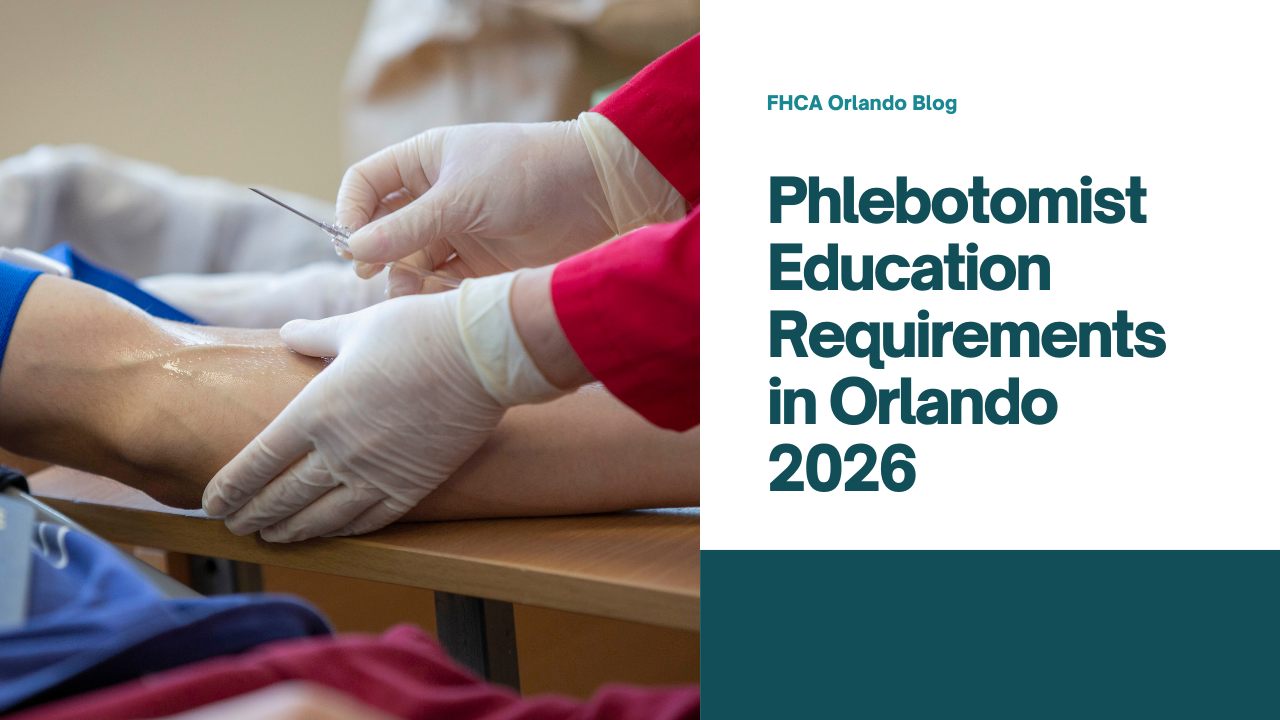Phlebotomist Education Requirements in Orlando 2026
Nov 26, 2025
Starting your healthcare career as a phlebotomist is a practical way to gain clinical experience and enter a fast‑growing medical field. If you’re ready to begin, our Phlebotomy program in Orlando provides hands-on instruction that prepares you for national certification and real clinical work.
At Florida Health Care Academy, we guide you step by step so you can meet all phlebotomist education requirements and build a stable career in hospitals, labs, and outpatient centers.
Table of Contents
- What are the phlebotomist education requirements to start your career
- What to expect from a phlebotomy training program
- Certification requirements for phlebotomists
- Continuing education units (CEUs) and phlebotomy education
- Is BLS certification part of phlebotomist education requirements
- Why choose FHCA Orlando for your phlebotomy education
- Phlebotomist education requirements Orlando 2026 FAQs
- Take the next step in your phlebotomy career
What are the phlebotomist education requirements to start your career
To begin a phlebotomy career in Florida, you must meet basic education requirements and complete specialized training. These steps ensure you can perform blood collection safely and accurately in healthcare environments.
High school diploma or GED
You need a high school diploma or GED before entering any phlebotomy training program. This foundation helps you understand medical procedures and prepares you for hands-on patient interaction.
Training schools and employers rely on this baseline to ensure you’re ready for clinical learning.
Phlebotomy training programs
After meeting the general education requirement, your next step is to complete a phlebotomy training program. At FHCA, we teach you venipuncture, infection control, specimen labeling, safety procedures, and patient care through classroom learning and supervised practice.
This approach prepares you to sit for your national certification exam and meet employer expectations from day one.

What to expect from a phlebotomy training program
Phlebotomy training includes classroom instruction, practice on training equipment, and supervised clinical experience. You learn both the technical and human aspects of performing safe blood draws.
Completing a recognized phlebotomist certification ensures you meet industry standards and employer expectations.
Curriculum overview
At FHCA Orlando, our phlebotomy curriculum covers anatomy, physiology, infection control, specimen processing, venipuncture, patient identification, lab safety, and proper documentation.
We designed our program to help you feel confident working in hospitals, diagnostic labs, and clinics. Reviewing practical phlebotomy tips can further reinforce the skills you build with us.
Hands-on experience
At FHCA, you complete clinical practice under the supervision of experienced instructors. This hands-on training includes live venipuncture procedures that build your confidence, precision, and readiness for real-world work.
The importance of clinical training is reinforced in the article on how to become a phlebotomist, which explains why hands-on experience is essential for skill development and job readiness.
Certification requirements for phlebotomists
To work as a phlebotomist in Florida, you must pass a national certification exam after completing your training. Accepted certifications include those from NHA, AMCA, or NCCT, and they test your knowledge in venipuncture, anatomy, safety, and patient interaction.
Earning certification is not optional; it’s required by most employers and proves you’re qualified to handle real patient care. For a full breakdown of the process, review how to get a phlebotomy certification, which outlines the exam requirements, documentation, and preparation tips.
Continuing education units (CEUs) and phlebotomy education
CEUs are required to keep your phlebotomy certification active. Most certifying agencies ask professionals to renew their credentials every one or two years through continuing education.
At FHCA, phlebotomy CEUs are affordable, self-paced, and designed to help you stay updated on safety protocols, new techniques, and patient care standards.
Is BLS certification part of phlebotomist education requirements
Many employers require BLS (Basic Life Support) certification as part of phlebotomy education. It prepares you to act quickly if a patient faints, goes into shock, or experiences cardiac distress during a blood draw.
Our phlebotomy training at FHCA Orlando includes CPR, airway management, and emergency response techniques to ensure you're fully prepared to maintain patient safety in clinical settings.
Why choose FHCA Orlando for your phlebotomy education
At Florida Health Care Academy, you´ll train with experienced instructors who focus on real-world skills. You´ll learn through hands-on practice, supportive classroom instruction, and preparation for national certification exams.
FHCA’s structured training helps you meet education requirements while building confidence in your technique. As shared in the benefits of being a phlebotomist, a strong training program gives you a solid start in the healthcare field and opens the door to long-term career opportunities.
Phlebotomist education requirements Orlando 2026 FAQs
This section answers the most common questions about phlebotomist education requirements in Florida for 2026.
What are the phlebotomist education requirements in Florida?
You need a high school diploma or GED, completion of a phlebotomy training program, and a national certification to qualify for most jobs.
How long do phlebotomist education requirements take to complete?
Most programs can be completed within months, allowing you to enter the workforce quickly and begin gaining clinical experience.
Are exams included in phlebotomist education requirements?
Certification exams are a mandatory step to meet hiring standards and validate your practical knowledge.
Can I meet phlebotomist education requirements without certification?
Most employers in Florida require certification for all phlebotomy roles, so completing the exam is highly recommended.
How do I get started with phlebotomist education requirements at FHCA Orlando?
Begin by applying to the training program. From there, you’ll receive classroom instruction, clinical experience, and support as you prepare for certification.
Take the next step in your phlebotomy career
If you're ready to meet the phlebotomist education requirements and start working in healthcare, our Phlebotomy program in Orlando gives you the training and confidence you need.
From practice to certification, FHCA guides you every step of the way. Begin your future by completing your Enrollment today.








